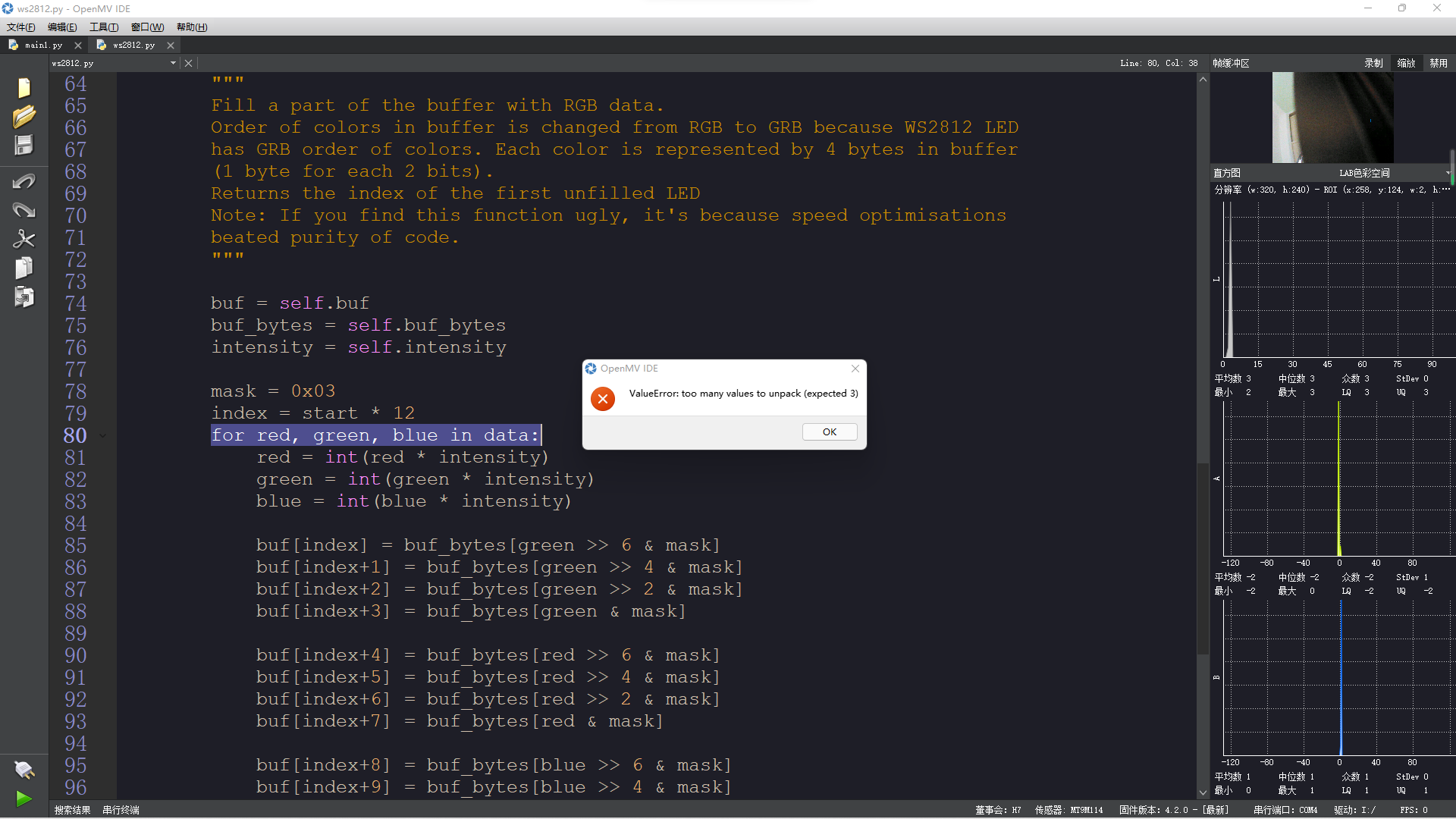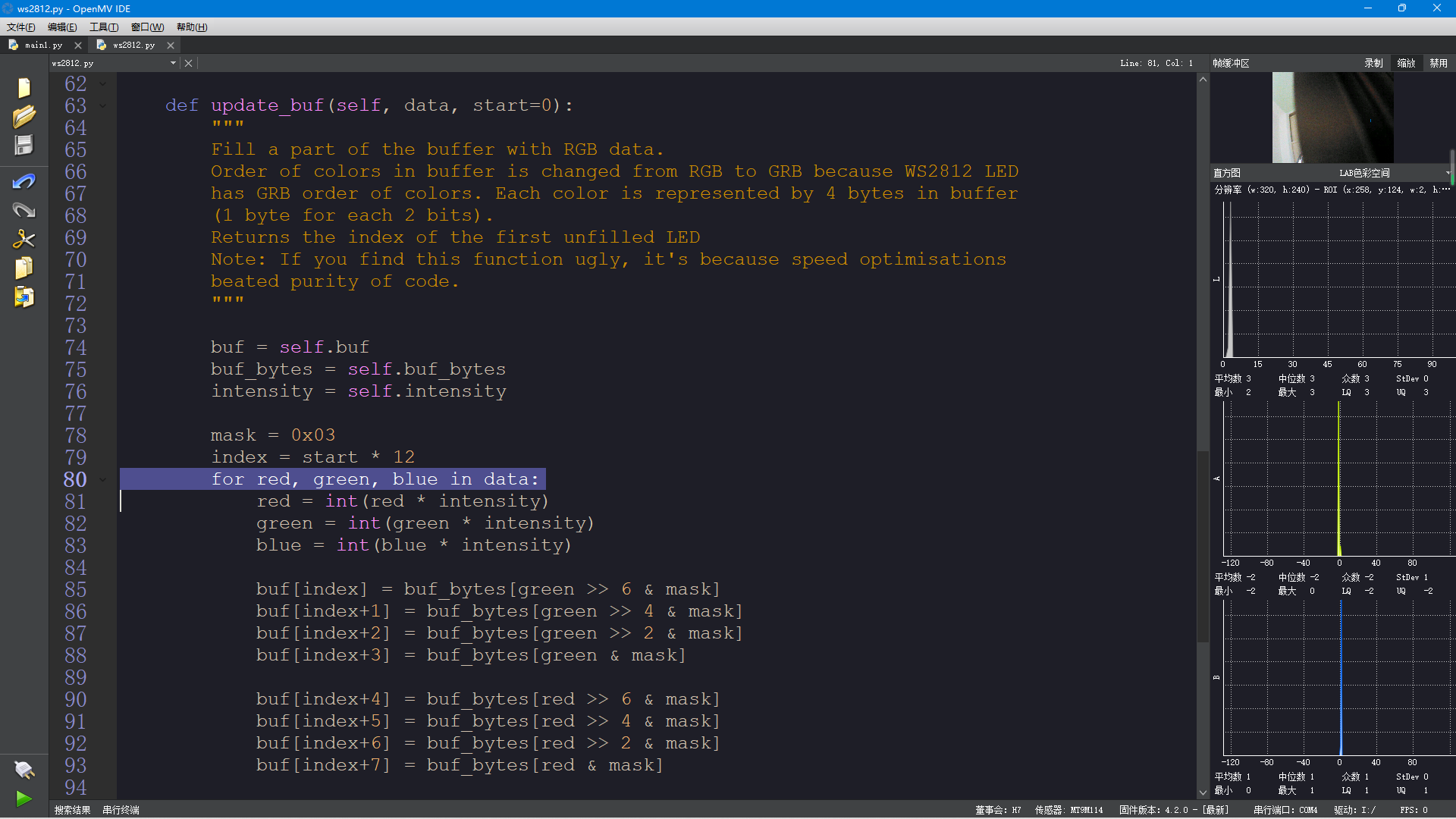在main1.py中使用70个RGB来点亮70颗RGB灯可以正常运行,但改成其它数量时就会报错:ValueError: too many values to unpack (expected 3)
此问题是在更新OpenMV IDE之后出现的。


# -*- coding: utf-8 -*-
import gc
try:
import pyb
except ImportError:
import machine as pyb
class WS2812:
"""
Driver for WS2812 RGB LEDs. May be used for controlling single LED or chain
of LEDs.
Example of use:
chain = WS2812(spi_bus=1, led_count=4)
data = [
(255, 0, 0), # red
(0, 255, 0), # green
(0, 0, 255), # blue
(85, 85, 85), # white
]
chain.show(data)
Version: 1.0
"""
buf_bytes = (0x88, 0x8e, 0xe8, 0xee)
def __init__(self, spi_bus=1, led_count=1, intensity=1):
"""
Params:
* spi_bus = SPI bus ID (1 or 2)
* led_count = count of LEDs
* intensity = light intensity (float up to 1)
"""
self.led_count = led_count
self.intensity = intensity
# prepare SPI data buffer (4 bytes for each color)
self.buf_length = self.led_count * 3 * 4
self.buf = bytearray(self.buf_length)
# SPI init
self.spi = pyb.SPI(2, pyb.SPI.MASTER, baudrate=3200000, polarity=0, phase=1)
# turn LEDs off
self.show([])
def show(self, data):
"""
Show RGB data on LEDs. Expected data = [(R, G, B), ...] where R, G and B
are intensities of colors in range from 0 to 255. One RGB tuple for each
LED. Count of tuples may be less than count of connected LEDs.
"""
self.fill_buf(data)
self.send_buf()
def send_buf(self):
"""
Send buffer over SPI.
"""
self.spi.send(self.buf)
gc.collect()
def update_buf(self, data, start=0):
"""
Fill a part of the buffer with RGB data.
Order of colors in buffer is changed from RGB to GRB because WS2812 LED
has GRB order of colors. Each color is represented by 4 bytes in buffer
(1 byte for each 2 bits).
Returns the index of the first unfilled LED
Note: If you find this function ugly, it's because speed optimisations
beated purity of code.
"""
buf = self.buf
buf_bytes = self.buf_bytes
intensity = self.intensity
mask = 0x03
index = start * 12
for red, green, blue in data:
red = int(red * intensity)
green = int(green * intensity)
blue = int(blue * intensity)
buf[index] = buf_bytes[green >> 6 & mask]
buf[index+1] = buf_bytes[green >> 4 & mask]
buf[index+2] = buf_bytes[green >> 2 & mask]
buf[index+3] = buf_bytes[green & mask]
buf[index+4] = buf_bytes[red >> 6 & mask]
buf[index+5] = buf_bytes[red >> 4 & mask]
buf[index+6] = buf_bytes[red >> 2 & mask]
buf[index+7] = buf_bytes[red & mask]
buf[index+8] = buf_bytes[blue >> 6 & mask]
buf[index+9] = buf_bytes[blue >> 4 & mask]
buf[index+10] = buf_bytes[blue >> 2 & mask]
buf[index+11] = buf_bytes[blue & mask]
index += 12
return index // 12
def fill_buf(self, data):
"""
Fill buffer with RGB data.
All LEDs after the data are turned off.
"""
end = self.update_buf(data)
# turn off the rest of the LEDs
buf = self.buf
off = self.buf_bytes[0]
for index in range(end * 12, self.buf_length):
buf[index] = off
index += 1
# Untitled - By: LENOVO - 周三 12月 8 2021
import sensor, image, time
from ws2812 import WS2812
from pyb import SPI
sensor.reset()
sensor.set_pixformat(sensor.RGB565)
sensor.set_framesize(sensor.QVGA)
sensor.skip_frames(time = 2000)
sensor.set_auto_whitebal(False)
#sensor.set_auto_exposure(False)
clock = time.clock()
spi = SPI(2, SPI.MASTER, baudrate=1000000, polarity=1, phase=0)
chain = WS2812(spi_bus=1, led_count=10) #(spi总线,灯珠数量)
#i = 1
#a = b = c = 0
while(True):
clock.tick()
img = sensor.snapshot()
sta = img.get_statistics(roi=(0,0,320,240)) #图像数据获取范围
s_l = sta.l_mean()
s_a = sta.a_mean()
s_b = sta.b_mean()
RGB = image.lab_to_rgb((s_l,s_a,s_b)) #lab to RGB
#RGB=(a,b,c)
data = [ #一行10个
RGB,RGB,RGB,RGB,RGB,RGB,RGB,RGB,RGB,RGB,
'''
RGB,RGB,RGB,RGB,RGB,RGB,RGB,RGB,RGB,RGB,
RGB,RGB,RGB,RGB,RGB,RGB,RGB,RGB,RGB,RGB,
RGB,RGB,RGB,RGB,RGB,RGB,RGB,RGB,RGB,RGB,
RGB,RGB,RGB,RGB,RGB,RGB,RGB,RGB,RGB,RGB,
RGB,RGB,RGB,RGB,RGB,RGB,RGB,RGB,RGB,RGB,
RGB,RGB,RGB,RGB,RGB,RGB,RGB,RGB,RGB,RGB,'''
#(i, 0, 0),
#(0, i, 0),
#(0, 0, i),
#(255, 0, 0),# red
#(0, 255, 0), # green
#(0, 0, 255), # blue
#(85, 85, 85), # white
]
#a = b = c = 255
#i = i + 2
'''if i==1:
a = 255
b=c=0
i=i+1
elif i==2:
a=c=0
b=255
i=i+1
else:
a=b=0
c=255
i=1'''
chain.show(data)
print("Lab",s_l,s_a,s_b)
print("RGB",RGB[0],RGB[1],RGB[2])